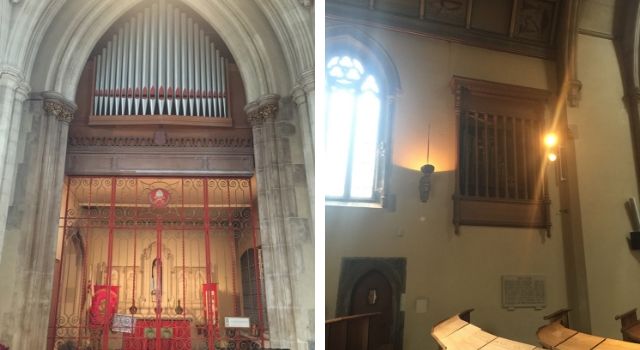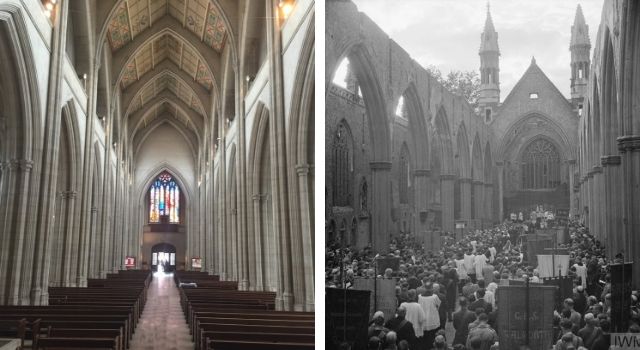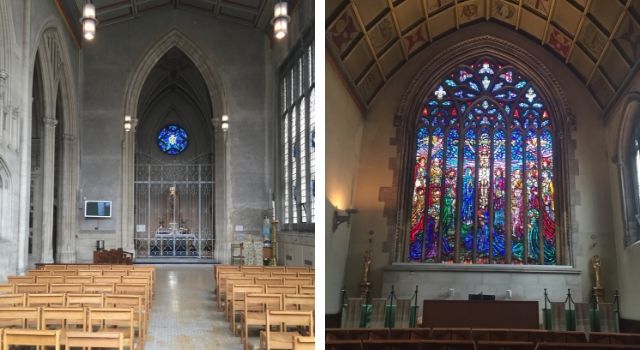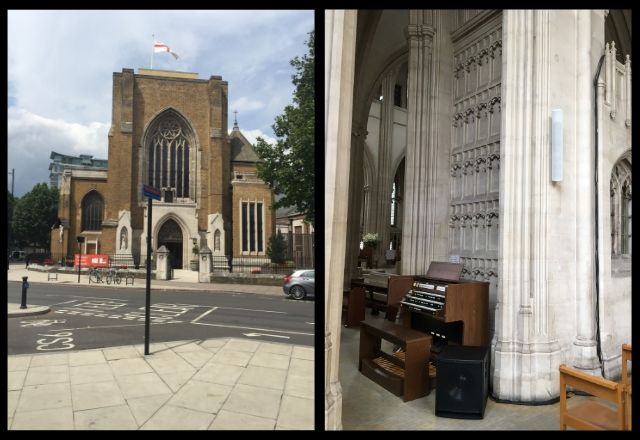On Tuesday July 9th 2019 we installed a hire organ in St George’s Cathedral Southwark. The 10th instrument currently on hire and for quite an unusual reason that I will explain below.
The following day I went in with my new colleague Richard Goodall to check out the installation and carry out some basic voicing. I needed an excuse to ‘get out’ for a day and never having been to St George’s it was an additional reason to visit.
Positioning of speakers important for a uniform sound
On site I met the cathedral architect who was interested to hear the hire instrument, speaking as it was from a very different location from the pipe organ. You will see the speaker position we used and perhaps contrast that with the unusually small pipe facades/grill through which the pipe organ speaks.

The pipe organ struggles to make its presence felt while our instrument could be heard uniformly at nearly all places in the building. This shows the importance of sound source locations to the overall effectiveness of an instrument. Our instrument spoke directly into the crossing where the sound very quickly mixed and travelled evenly down nave and both north and south aisles.

The pipe organ speaks into the south aisle and through a small grill into the choir. From these small ‘openings’ sound does not flow into the nave and ‘hot spots’ develop despite the substantial resonance of the building. But I digress why were we there at all?
The Compton Pipe Organ at St George
The Compton pipe organ at St George’s is built on the extension principal so has complex electronics connecting the detached console to the pipes and recently this has been unreliable. New solid state electronics have been fitted so it is hoped the problems are resolved.
But with a new Archbishop being installed there on July 25th the Cathedral is taking no chances and have hired a Viscount instrument as back up. There is also a very large wedding taking place so other important services are scheduled for which a reliable instrument is essential.

St George’s Cathedral, built by renowned architect Augustus Pugin, was near destroyed by a fire bomb in World War II. The rebuilding got underway fairly quickly using the original footprint but increasing the height of the central nave and replacing traditional pitched roof aisles with flat roofs.
Voicing of the digital hire organ
The building today is spectacularly light with a very lively acoustic which makes organ voicing rather easier than is the case in dead buildings. After about an hours work we had knocked the very obvious issues off. Certain pedal notes booming around the ‘natural resonant’ point of the building were resolved. The pedal bourdon was lifted a bit in volume so it was clearly purring nicely under the flute chorus.

We got a good distinction between the volumes and tone of the 4 diapason stops, 2 on the great and one each on swell and choir. We replaced the choir tuba for a brighter louder voice that could cut through full great with swell coupled. HERE is a recording of our Envoy 350-FV instrument after the voicing session, or if you do not mind a few wrong notes view the video below which also shows you the interior of this magnificent building.
I remarked to a friend that if any more hire request came in, we might run out of instruments. He reassuringly retorted that we would run out of cathedrals long before we ran out of instruments. Watch out for the story of Edinburgh Episcopal Cathedral that we will install in September!
Find out more about our organ hire service or read more organ hire stories on our blog.
I have had a passion for church organs since the tender age of 12. I own and run Viscount Organs with a close attention to the detail that musicians appreciate; and a clear understanding of the benefits of digital technology and keeping to the traditional and emotional elements of organ playing.



